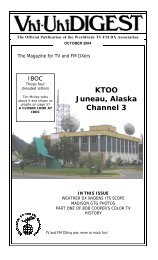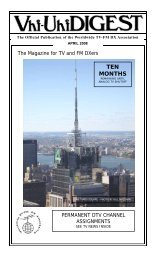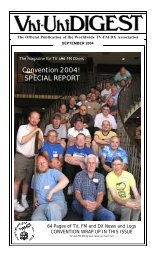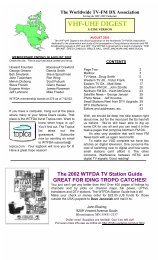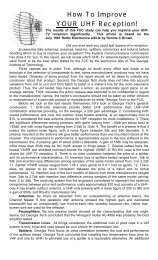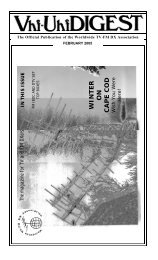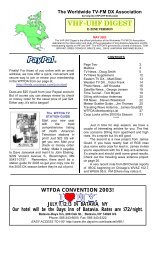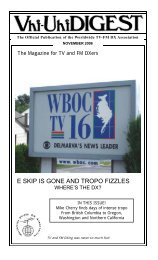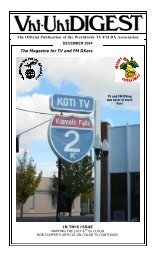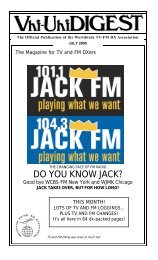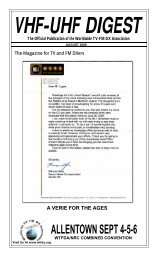Digital <strong>TV</strong>…The Beat Goes OnREPRINTED FROM A RECENT DISCUSSION ON THE WTFDA LISTYou may remember a while back Pax suggested channels 60-69 could be cleared faster if they wereallowed to move their analog stations up there to their D<strong>TV</strong> channels - presumably switching directlyto digital at transition time without any simultaneous analog/digital operation. It looks like they may betrying to force the issue. Six of Pax's analog stations have applied to move to their D<strong>TV</strong> assignments.The stations involved are: WPPX-61 Wilmington, Delaware to channel 31, 800kw/374m, WXPX-66Bradenton, Florida to channel 42, 2240kw/476m, WBPX-68 Boston, Mass. to channel 32,700kw/292m, WPXQ-69 Block Island, RI to channel 17, 4000kw/200m, KPXD-68 Arlington, Texasto channel 42, 1750kw/541m and WWPX-60 Martinsburg, W.Va. to channel 12, 45kw/314mYes, that would make a new analog <strong>VHF</strong> station on the East Coast. (Doug Smith)________________________________________________________________________________How in the world could they "shoehorn" in this kind of assignment for a new NTSC station? A channel12 in Martinsburg WV would be hemmed in by the following: WBOY-12 Clarksburg WV, WWBT-12Richmond VA and WHYY-12 Wilmington DE. Surely they can't be serious in asking for this. (DaveAustin)________________________________________________________________________________This is very interesting. Am I correct that each of these stations could in the long run count as threeloggings? For example, KPXD-68 DFW is currently in my log as an analog on 68. Next, it could bean analog on 42. And eventually (providing I get a decoder) it will switch to digital and be logged asa D<strong>TV</strong> entry.??? (Danny Oglethorpe)________________________________________________________________________________________You've posed a very interesting question here and it will come up often in the future. After thetransition (probably not in my lifetime) most <strong>VHF</strong> analog stations that operate their digital stations on<strong>UHF</strong> will revert back to their orginal <strong>VHF</strong> channels. For example, our plan at KTWU-11 is to operateon channel 11 (NTSC) and D<strong>TV</strong> channel 23 during the transition. At the end of the transition we willturn off NTSC channel 11 and digital channel 23 and operate only on D<strong>TV</strong> channel 11. Is that threeloggings for KTWU? All will be from the same location and two of them on the same channel.Our reason for going to digital on channel 11 is the lower power cost for <strong>VHF</strong>. The upper <strong>VHF</strong>channels should work OK for digital while there is some concern about the viability of D<strong>TV</strong> onchannels 2-6. The chief engineer for KSWK-3 says that they have not made a decision. Also, I haveheard the same about WDAF-4 and KC<strong>TV</strong>-5 in Kansas City. I guess only time will tell if the low bandworks for D<strong>TV</strong>.Perhaps we should keep two logs--one for analog and one for digital. (Dave Pomeroy)________________________________________________________________________________________Unfortunately, there will be a lot of these situations where channels are squeezed into too small of aspace. Apparently the FCC didn't learn much back in the late 40's when they had to freeze <strong>VHF</strong>grants, move some <strong>VHF</strong> channels around and create <strong>UHF</strong>.There have already been interference problems and not many D<strong>TV</strong> stations are on the air yet. TheD<strong>TV</strong> 8 in Milwaukee has caused a lot of problems for viewers of channel 8 from Grand Rapids. Inthis area the FCC has allowed KMBC-9 in Kansas City to go to D<strong>TV</strong> channel 7 instead of D<strong>TV</strong>channel 14. When I lived in KC I could always receive KE<strong>TV</strong>-7 from Omaha and KOAM-7 fromPittsburg, KS. There will be problems for viewers of KE<strong>TV</strong> and KOAM-<strong>TV</strong>. KOAM was to operate onD<strong>TV</strong> channel 30, but has now been granted a permit for D<strong>TV</strong> channel 13. Their channel 7 signal hasan overlap with channel 13 in Fayetteville, AR. There will be real problems for KAFT, KRCG andWIBW which circle Pittsburg.The FCC really doesn't seem to care too much about what happens to over-the-air television and thebroadcasters don't seem to care about anything other than cutting their costs. Many viewers will loseout. (Dave Pomeroy)________________________________________________________________________________________With the NTSC assignments, the FCC assumes a station will be using the maximum power for itschannel and a non-directional antenna. Channel 12 at Martinsburg, WV would be assumed to use316kw/300m, and could only be assigned if they could run that much power without interfering withWBOY, WWBT, or WHYY. (obviously that's not possible - if it could be done, someone would havesuccessfully petitioned to get channel 12 assigned decades ago!)
To shoehorn in D<strong>TV</strong> assignments while simultaneously removing 17 channels, they had tochange that assumption. If a directional antenna makes it possible to make an assignmentwithout interfering, it will be authorized. And coverage is predicted on the actual power of astation, not the maximum for its class.WWPX on channel 12 would run 37.9kw in the direction of WHYY. (and WHYY already usesa directional antenna which radiates only 250kw in the direction of WWPX) WWPX would run41.4kw in the direction of WWBT, and only 2kw in the direction of WBOY. (which runs 263kwnon-directional, roughly 50kw less than the class maximum) The minimum separationbetween <strong>VHF</strong> stations on the same channel in Zone I (where all four stations are) is 170miles; WHYY is 155 miles from WWPX; WWBT is 138; and WBOY is 122.In Zone II (where Kansas and Missouri are) the minimum separation is 190 miles. KMBC-DT7 is 173 miles from KE<strong>TV</strong>, and 129 miles from KOAM. They null slightly towards KE<strong>TV</strong>(76.7kw compared to an average of 85kw at all azimuths). And there's a deep null - like I'mused to seeing on *AM* stations - towards KOAM. 2.3kw in that direction, compared to 85kwaverage.Another NTSC short-spacing has been applied for in my neck of the woods. WNAB-58 hasbeen operating at just about exactly the minimum distance (175 miles) from WFTE-58 Salem,Indiana. They've now applied to move their NTSC antenna to their *D<strong>TV</strong>* site - which is only153 miles from WFTE. Again, a directional antenna is involved...The name of the game these days seems to be qualifying for must-carry. If you can establisha theoretical minimum signal strength at the head-end, then you can install a fiber-optic link toactually get the programming there, and you really don't care that the actual reception at thehead-end is noisy & full of interference. Only 20-25% of the audience doesn't have cable -much of that has satellite instead. The ones who have neither either don't watch much <strong>TV</strong>(and thus aren't worth spending money on) or can't afford cable/satellite. (and thus can'tafford much of anything else, and thus aren't worth advertising to)The additional expenses of running a <strong>UHF</strong> D<strong>TV</strong> facility are pretty high. Electricity costs havealways been a major part of the budget of a <strong>UHF</strong> station, and there's been a LOT of researchover the years into methods of cutting these costs. There's been some success, but <strong>UHF</strong> stillcosts far more than <strong>VHF</strong>. (and one of the more successful cost-cutting methods, "anodepulsing", only works for analog. It doesn't work for digital.) With the D<strong>TV</strong> transmitter bringingno significant revenue for some time to come, it really doesn't make much business sense tospend any more on it than necessary.(Imagine that Ford invented a new type of car. It could be driven safely at 200mph onexisting freeways. But it only gets 5mpg if driven slower than 100mph, can only be drivensafely faster than 75 if every car on the road is of the new type, and costs $50,000. Does thestate pass a law only permitting new-type cars on the freeways? Where does that leave youif you can't afford $50,000 for a new car? If the state *doesn't* pass that law.. who will everbuy a new-type car if it costs $50,000 and gets 5mpg?That's pretty much what we've run into with D<strong>TV</strong>. Until/unless everyone buys it, the newtechnology is mostly just a drain on the industry.)There *has* been an interesting resurgence in interest in over-the-air reception lately though.It first came up after the Sept. 11 attacks, when the number who complained about not beingable to see the Alpine, NJ temporary site surprised a lot of people. And it was emphasizedwhen NBC switched its affiliation to KN<strong>TV</strong>-11 in the San Francisco market, and realized justhow many people were unable to see the station in the northern part of the market. (at thesame time, some San Jose print journalists were reminding San Franciscans that the largercity at the other end of the bay had been dealing with this problem for 50 years...) Whetherit'll hold, or the industry will join the FCC in saying "let them get cable", is a good question.(Doug Smith)



